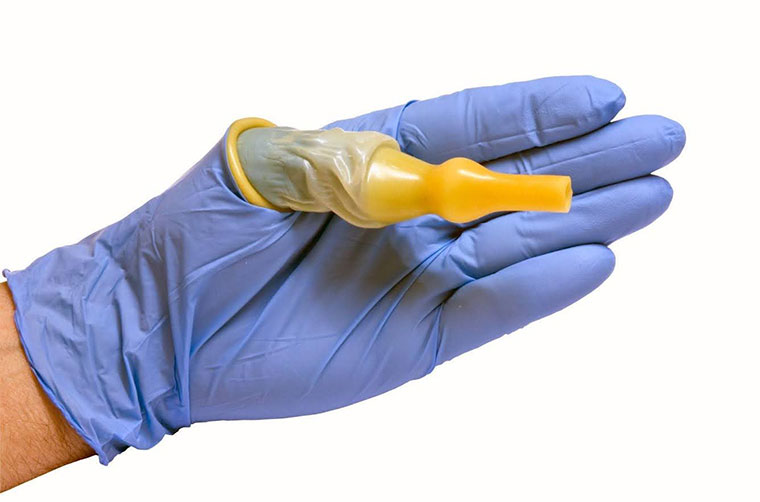Pressure Injuries & Condom Catheters

Urinary incontinence affects a significant percentage of men, particularly those with neurological disorders, mobility limitations, or post-surgical complications. It can lead to embarrassment, reduced quality of life, and challenges in maintaining hygiene. To manage urine leakage, some men turn to external devices like condom catheters, which fit over the penis and direct urine into a collection bag. Unlike indwelling catheters that are inserted into the bladder, condom catheters are considered less invasive and are often recommended for long-term use in bedridden or incontinent male patients.
Introduction
While condom catheters are marketed as a safer alternative, they come with serious risks. Studies have reported complications such as penile strangulation, tissue necrosis, and severe infections, particularly when the device is misapplied or left unattended for too long. Poor sizing, adhesive-related skin injuries, and inadequate monitoring contribute to these dangers. Although penile strangulation from condom catheters is rare, documented cases emphasize the need for proper care, especially in patients with neurological impairments who may not feel early warning signs.
This article highlights the hidden risks of condom catheters, exposing the potential for severe complications and discussing safer alternatives for men with urinary incontinence. Understanding these risks is essential to making informed decisions about incontinence management.
Understanding Condom Catheters
A condom catheter is an external urinary device designed for men experiencing incontinence. It fits over the penis like a condom and is connected to a drainage bag via a tube, allowing urine to flow out of the body without requiring an internal catheter. This makes it a non-invasive alternative to indwelling catheters, which are inserted into the bladder.
These devices are widely used among men with limited mobility, neurological conditions, or age-related bladder dysfunction. Many healthcare providers recommend them for their ease of use and reduced risk of urinary tract infections (UTIs) compared to Foley catheters. Unlike indwelling catheters, condom catheters do not require insertion into the urethra, reducing discomfort and the likelihood of internal trauma.
However, condom catheters also have serious risks. If not applied properly or monitored regularly, they can cause skin irritation, pressure injuries, and even penile strangulation. In some cases, prolonged use has led to severe complications, including necrosis, requiring surgical intervention. While they seem like a convenient solution, the potential dangers highlight the need for careful consideration and proper alternatives in incontinence management.
Serious Risks of Condom Catheters
Penile Strangulation and Necrosis
One of the most severe complications is penile strangulation, which occurs due to incorrect sizing or prolonged use leading to ischemia and necrosis. A case study describes an 86-year-old male patient with severe dementia who developed gangrene of the glans penis after prolonged condom catheter use. The patient required debridement and skin graft reconstruction, highlighting the potential for devastating outcomes when catheter care is inadequate.
A similar study described a 64-year-old man with diabetes who suffered ischemic necrosis due to improper condom catheter use. Research also indicates that penile necrosis due to condom catheter use is more common in patients with diabetes and vascular disease, where compromised blood flow exacerbates the risk of tissue damage.
Severe Penile Injury and Penile Gangrene
Penile injuries resulting from condom catheter use can be severe, particularly in cases where excessive pressure leads to ischemic damage. A review of urological injuries found that strangulation injuries leading to gangrene are often underreported, with delayed diagnosis contributing to poor outcomes. Another study reported multiple cases of penile gangrene linked to condom catheter use, where the combination of adhesive trauma and restricted blood flow resulted in irreversible tissue damage.
Skin Irritation and Pressure Injuries
Skin injuries, including dermatitis, ulcerations, and necrosis, are common among long-term condom catheter users. The adhesive materials, latex, and friction can cause significant skin irritation, leading to painful ulcers and long-term damage. Up to 15% of long-term users experience such complications, with bedridden and neurologically impaired patients at higher risk. Inadequate hygiene and improper catheter care further exacerbate these issues. Ensuring that condom catheters are changed every 48 hours, maintaining proper hygiene, and inspecting for early signs of irritation are critical preventive measures.
Increased Risk of Urinary Tract Infections (UTIs)
Condom catheters are associated with a significant risk of urinary tract infections (UTIs), with studies reporting that up to 40% of long-term users develop UTIs . Improper drainage, retained moisture, and bacterial colonization contribute to this risk. The warm and moist environment created by condom catheters provides an ideal setting for bacterial growth, particularly in debilitated or immunocompromised patients. Proper hygiene, routine catheter changes, and early intervention at the first signs of infection are necessary to mitigate this risk.
Dislodgement and Leakage Issues
One of the most frequent problems with condom catheters is dislodgement, leading to urine leakage and associated hygiene concerns. Leakage can cause embarrassment and discomfort while increasing the risk of skin infections due to prolonged exposure to urine. Improper sizing and adhesive failure are common causes of detachment. Ensuring that the correct size is selected and that the catheter is secured properly without excessive constriction is key to preventing these issues.
Comparison with Other Incontinence Management Options
Indwelling and Intermittent Catheters
One study and recent trials have highlighted the complications associated with indwelling urethral catheters, particularly regarding non-infectious issues such as discomfort and pain. Condom catheter users reported significantly less pain related to device placement compared to those using indwelling catheters. In one trial, patients using condom catheters also experienced fewer complications such as bacteriuria and symptomatic UTIs. However, indwelling catheters, while effective for certain populations, can cause pain during insertion and removal and may lead to complications like urinary tract infections if not managed properly. This underlines the importance of considering patient comfort and complication rates when selecting a device.
Male External Collection Devices
Male external collection devices, including modern condom catheters, are becoming a safer alternative to traditional methods. Newer versions of these devices have addressed many past issues, such as slippage or discomfort. However, some users still experience challenges with the device staying in place, particularly during movement or when lying down, which can impact overall satisfaction. Despite this, external collection devices offer a more comfortable, convenient option, especially when compared to the risks associated with long-term catheter use.
Absorbent Pads and Wraps
Modern absorbent products, like QuickChange Wraps, provide significant advantages in terms of skin health, comfort, and hygiene for male patients managing urinary incontinence. Our findings indicate that, while many non-infectious complications are common with urinary devices, absorbent pads and wraps are less likely to cause these issues. Additionally, they allow for a more discreet, comfortable fit, making them ideal for active individuals.

Best Practices for Those Who Still Use Condom Catheters
Condom catheters are commonly used to manage male urinary incontinence; however, their improper use can lead to serious complications.
Proper Sizing and Application
Ensuring the correct size and proper application of a condom catheter is crucial to prevent adverse outcomes. An overly tight catheter can cause penile strangulation, leading to necrosis. A case study reported penile gangrene resulting from the continuous tourniquet effect of a condom catheter, emphasizing the importance of correct placement and monitoring.
Routine Skin Checks and Care
Regular inspection of the penile skin under the condom catheter is essential. Complications such as skin erosion, inflammation, and necrosis have been documented. For example, a 73-year-old bedridden male developed penile skin erosion after four days of condom catheter application, necessitating surgical intervention. Routine skin assessments can aid in early detection and management of such issues.
When to Seek Medical Help
Seek immediate medical attention if you experience pain during catheter placement, swelling, redness, or signs of infection such as warmth or discharge. Early intervention is crucial to address complications before they become severe.
Conclusion
While condom catheters may seem like a convenient solution for managing urinary incontinence, their long-term use can lead to serious health risks. From penile strangulation and tissue necrosis to skin irritation and urinary tract infections, improper use of condom catheters can have devastating consequences, particularly for those with mobility limitations or neurological impairments.
It is crucial for male patients and their caregivers to explore safer and more reliable alternatives for managing urinary incontinence. Absorbent products like QuickChange Wraps offer a more comfortable, discreet, and hygienic option that minimizes the risks associated with external urinary devices.
For those seeking support, we invite you to purchase a 10 Count Trial Pack here or request a professional-use sample pack for healthcare institutions here.
References:
-
Chaker, K., Ouanes, Y., Rinchi, M., Cherni, N., Bibi, M., Dali, K. M., & Nouira, Y. (2023). Penile gangrene due to improper application of a condom catheter: A case report. J Med Case Rep, 17(1), 30. https://doi.org/10.1186/s13256-023-03771-x
-
Fakih, M. G., Watson, S. R., Greene, M. T., Kennedy, E. H., Olmsted, R. N., Krein, S. L., & Saint, S. (2012). Reducing inappropriate urinary catheter use: A statewide effort. Arch Intern Med, 172(3), 255-260. https://doi.org/10.1001/archinternmed.2011.627
-
Golji, H. (1981). Complications of external condom drainage. Paraplegia, 19(3), 189-197. https://doi.org/10.1038/sc.1981.40
-
Larsen, E. B., Fahnøe, C. L., Jensen, P. E., & Gregersen, M. (2023). Absorbent incontinence pad use and the association with urinary tract infection and frailty: A retrospective cohort study. Int J Nurs Stud Adv, 5, 100131. https://doi.org/10.1016/j.ijnsa.2023.100131
-
Özkan, H. S., İrkoren, S., & Sivrioğlu, N. (2015). Penile strangulation and necrosis due to condom catheter. Int Wound J, 12(3), 248-249. https://doi.org/10.1111/iwj.12102
-
Saint, S., Krein, S. L., Fowler, K. E., Colozzi, J., Ratz, D., Lescinskas, E., Chrouser, K., & Trautner, B. W. (2019). Condom catheters versus indwelling urethral catheters in men: A prospective, observational study. J Hosp Med, 14, E1-E4. https://doi.org/10.12788/jhm.3180
-
Sinha, A. K., Kumar, N., Kumar, A., & Singh, S. (2018). Condom catheter induced penile skin erosion. J Surg Case Rep, 2018(10), rjy275. https://doi.org/10.1093/jscr/rjy275
-
van Mastrigt, R., Pel, J. J., Chung, J. W., & de Zeeuw, S. (2009). Development and application of the condom catheter method for non-invasive measurement of bladder pressure. Indian J Urol, 25(1), 99-104. https://doi.org/10.4103/0970-1591.45546
-
Zaghbib, S., Chakroun, M., Saadi, A., Boussaffa, H., Bouzouita, A., Derouiche, A., Ben Slama, M. R., Ayed, H., & Chebil, M. (2019). Severe penile injury due to condom catheter fixed by a rubber band: A case report. Int J Surg Case Rep, 64, 120-122. https://doi.org/10.1016/j.ijscr.2019.10.009


